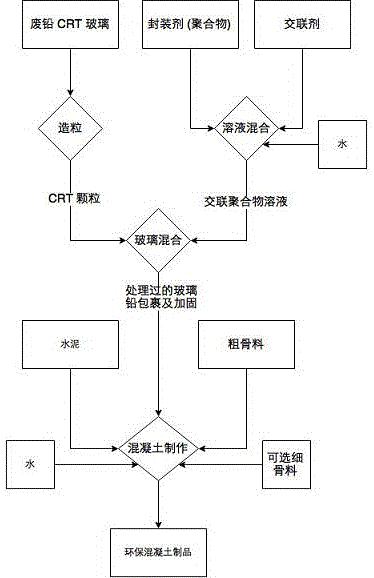Method for transforming lead glass into environment-friendly concrete raw material by using natural biological material
A technology of environmentally friendly concrete and biomaterials, applied in the field of environmentally friendly building materials, can solve the problems of unknown by-product lead content and treatment methods, CRT waste, damage to economic benefits, etc., and achieve economic feasibility and reduce lead leaching.
- Summary
- Abstract
- Description
- Claims
- Application Information
AI Technical Summary
Problems solved by technology
Method used
Image
Examples
Embodiment 1
[0039] 1. Prepare biopolymer solution.
[0040] Weigh 32g of locust bean gum and dissolve it in 1568g of water to obtain a 2%w / w locust bean gum solution.
[0041] 2. Prepare cross-linking agent solution.
[0042] Weigh 8g of crystalline boric acid and dissolve it in 392g of water to obtain a 2%w / w boric acid solution.
[0043] 3. Preparation of cross-linked biopolymer solution.
[0044] 1600 g of 2% w / w locust bean gum solution was mixed with 400 g of 2% w / w boric acid solution to obtain a cross-linked biopolymer solution.
[0045] 4. CRT lead glass treatment.
[0046] CRT lead glass is crushed and granulated, and the particle size after crushing is less than 1.5 mm. 10 kg of lead-containing glass is evenly coated and the solution is completely mixed until 100% of the particle size passes through a mesh of 1.5 mm.
[0047] 5. Preparation of concrete.
[0048] Mix 5kg of Portland cement, 10kg of treated CRT lead glass, and 15kg of stones with a particle size of 6-30mm, an...
Embodiment 2
[0054] 1. Prepare biopolymer solution.
[0055] Weigh 8g of guar gum and dissolve it in 792g of water to obtain a 1%w / w guar gum solution.
[0056] Weigh 8g of xanthan gum and dissolve it in 792g of water to obtain a 1%w / w xanthan gum solution.
[0057] Mix 1%w / w guar gum solution with 1%w / w xanthan gum solution at a ratio of 1:1 to obtain guar gum-xanthan gum biopolymerization solution.
[0058] 2. Prepare cross-linking agent solution.
[0059] Weigh 4g of 50%w / w glutaraldehyde stock solution and add it into 226g of water to obtain 0.9%w / w glutaraldehyde solution.
[0060] 3. Preparation of cross-linked biopolymer solution.
[0061] 1600 g of 1% w / w guar-xanthan gum biopolymer solution was mixed with 230 g of 0.9% w / w glutaraldehyde solution to obtain a cross-linked biopolymer solution.
[0062] 4. CRT lead glass processing.
[0063] CRT lead glass is crushed and granulated, and the particle size after crushing is less than 1.5 mm. 10 kg of lead-containing glass is evenl...
PUM
| Property | Measurement | Unit |
|---|---|---|
| Particle size | aaaaa | aaaaa |
Abstract
Description
Claims
Application Information
 Login to view more
Login to view more - R&D Engineer
- R&D Manager
- IP Professional
- Industry Leading Data Capabilities
- Powerful AI technology
- Patent DNA Extraction
Browse by: Latest US Patents, China's latest patents, Technical Efficacy Thesaurus, Application Domain, Technology Topic.
© 2024 PatSnap. All rights reserved.Legal|Privacy policy|Modern Slavery Act Transparency Statement|Sitemap


